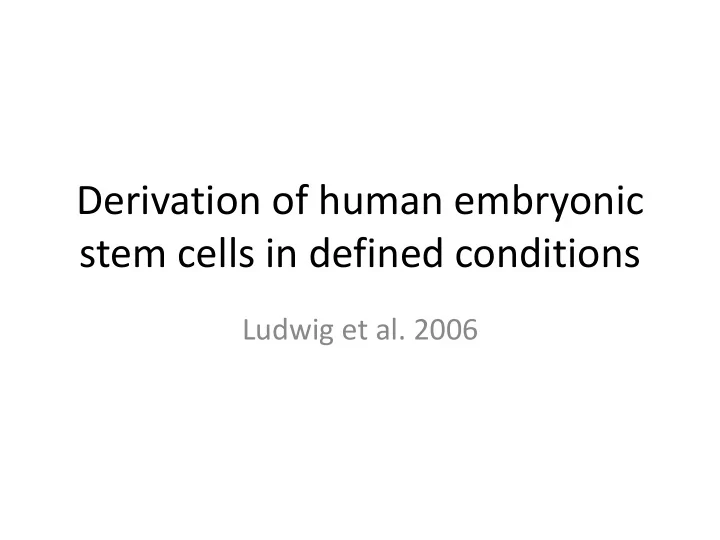

Derivation of human embryonic stem cells in defined conditions Ludwig et al. 2006
Robert Warren, Age 20 TBI in War in Afghanistan EzineMark.com 07/22/11
The Promise of Stem Cells
What are Stem Cells? • Multipotent or Pluripotent Cell Types • Immortal • Asymmetric Divisions
What are the different types of Stem Cells? • Adult Stem Cells • Embryonic Stem Cells • Induced Pluripotency Stem Cells
Stem Cells Can Turn Into Any Cell in the Body and Have a Number of Uses 1. Cell Therapy
How Can Stem Cells be Used for Cell Therapy? Biopsy Six Defined Stem Cell Genes Patient Adult Stem Embryonic Induced Pluripotent Patient Specific Cells Stem Cells Stem Cells Differentiated Cells
Stem Cells Can Turn Into Any Cell in the Body and Have a Number of Uses 1. Cell Therapy 2. Drug Screening 3. Toxicology Screening 4. Developmental Modeling National Geographic News, 2008
Pluripotency is a unique state. How do you know whether your Pluripotent stem cell is Pluripotent?
You can determine if your cell is pluripotent by testing to see if it is capable of contributing to every tissue type in a live animal.
Chimeras are animals that have two or more different genotypes within the same individual. Chimeras Chimeras
Another Key Characteristic of Pluripotent Stem Cells is They are Capable of Incorporating into the Germline (Germline Competent).
How Could You Use Pluripotent Stem Cells In Domestic Livestock that are Capable of Producing Germline Competent Chimeric Animals?
Agriculture: Improving Livestock • Disease Resistant Animals • Feed Efficient Animals • Animals with Improved Traits of Interest
Biomedical Applications • Introduce genes to create transgenic animals for: – human disease modeling – produce humanized animals for xenotransplantation
The pre-2006 hESC culture system presented a number of challenges for cell therapy 1.Grown on feeder cells 2.Media contains fetal bovine serum Both of these have undefined factors, can be inconsistent in factors and concentrations and are a potential source of zoonotic, prion, viral contamination and exchange of information between feeder cells and hESCs (Neu5Gc- sialic acid)
What do you need to consider when you are going to develop a new cell culture system? 1. Media 2. Substrate a) Nutrition a) Cell adherence b) pH b) Cell signaling c) Osmolarity d) Maintenance signaling 3. Other factors e) Antioxidents a) Oxygen Levels f) Antibiotic and antimicotic b) Xeno Free c) Ease of obtaining d) Cost
Where to start: signaling pathways potentially can be manipulated
Big Picture Question Can they develop a human embryonic stem cell culture system that only uses defined factors that is capable of maintaining these cells in a pluripotent state.
Can the TeSR1 culture system maintain the proliferation rate and pluripotency marker expression?
Which TeSR1 factors are critical to maintaining stem cell proliferation?
Which TeSR1 factors are critical to maintaining stem cell marker expression?
Are hESCs capable of maintaining Karyotype after long term culture in TeSR1?
Are hESCs capable of forming all 3 germ layers via teratoma differentiation after long term culture in Analysis of TeSR1?
Can cells morphologically resembling stem cells be derived in TeSR1 and modified substrate?
Do putative hESCs derived in TeSR1 express stem cell markers?
Do putative hESCs derived in TeSR1 express stem cell markers?
Are hESCs derived in defined conditions karyotypically normal?
Big Picture Conclusion hESCs can be expanded and derived under defined conditions utilizing TeSR1 media on a human matrix.
What are some of the strengths of this paper? • Used multiple stem cell lines • Used multiple stem cell markers • Quantitative approaches
Recommend
More recommend